Manneken Pis
| Manneken Pis | |
|---|---|
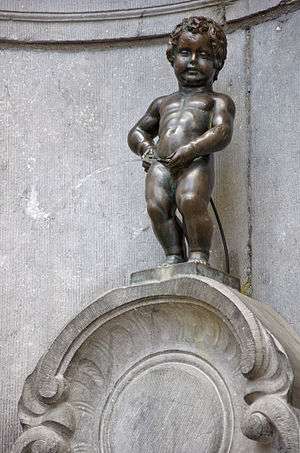 | |
| Artist | Jerome Duquesnoy |
| Year |
1619: original version 1965: current version |
| Type | Bronze |
| Dimensions | 61 cm (24 in) |
| Location | Brussels |
| 50°50′42″N 4°21′00″E / 50.84499°N 4.34998°ECoordinates: 50°50′42″N 4°21′00″E / 50.84499°N 4.34998°E | |
Manneken Pis (![]()
Manneken Pis is the best-known symbol of the people of Brussels. It also embodies their sense of humour (called zwanze[7] in the Brussels' dialect) and their independence of mind.
Etymology
To be precise, the real name of the statue is Menneke Pis. In fact, in the dialect of Brussels, een manneke means a small man, whereas een menneke means a little boy (it is the diminutive of men: boy).
Manneken Pis is sometimes given the nickname of Petit Julien or Julianske ("Little Julien"), which in fact refers to a now-disappeared fountain of Julian (Juliaenkensborre), by mistakenly confusing two well-distinct fountains.[5]
History
Origins of Manneken Pis
The earliest mention of the existence of Manneken Pis can be found in an administrative text, dating from 1451–1452, about the water lines supplying the fountains of Brussels. From the beginning, the fountain played an essential role in the distribution of drinking water. It stood on a column and poured water into a double rectangular basin of stone. The only representations of this first statue can be found, very schematically, in a painting by Denis Van Alsloot, representing the Brussels' Ommegang of 1615 and in a preparatory drawing to this painting.[5]
The first statue was replaced by a new bronze version, commissioned in 1619. This 61-centimetre (24 in) tall bronze statue, on the corner of Rue de l'Étuve and Rue des Grands Carmes, was made by Brussels' sculptor Hieronimus Duquesnoy the Elder (1570–1641), father of Jérôme Duquesnoy the Young and the famous François Duquesnoy. It was probably cast and installed in 1620. During this time, the column supporting the statue and the double rectangular basin collecting water were completely remodeled by Daniel Raessens.[5]

During its history, the statue faced many hazards. It survived undamaged the bombardment of Brussels of 1695 by the French army, but the pipes having been affected, it could not deliver its water for some time. A pamphlet published the same year recounts this episode. This text is the oldest attesting that Manneken Pis had become "an object of glory appreciated by all and renowned throughout the world". It is also the first time that it served as a symbol for the people of Brussels. It is also traditionally said that after the bombardment, it was triumphantly placed again on its pedestal. On that occasion, the following passage from the Bible was inscribed above its head : In petra exaltavit me, et nunc exaltavi caput meum super inimicos meos ("The Lord placed me on a stone base, and now I raise my head above my enemies"). As shown by an engraving by Jacques Harrewijn, dating from 1697, the fountain was no longer located on the street, but in a recess at the corner of the Rue du Chêne and de l'Étuve.[5]
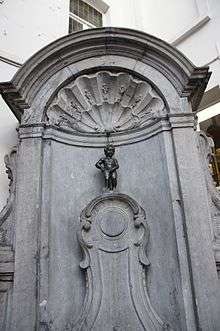
In 1770, the column and the double rectangular basin disappeared; the statue was integrated into a new decor, in the form of a stone niche in rockery style, originating from another dismantled fountain of Brussels. The water simply flowed through a grating in the ground, which was replaced by a basin, in the 19th century. In its new setting, Manneken Pis gives the impression of being smaller than in its original layout.[5]
The whole structure is protected by railings, the last version of which dates from 1851. The latter prevented access to water, relegating the fountain to a decorative and symbolic role.[5] It is also the case, around the same time, of the other fountains in Brussels. This correlates with efforts by the City of Brussels, starting in 1855, to allow for the distribution of drinking water in homes.[8]
The figure has repeatedly been the object of theft or attempted theft. Legend has it that the statue was removed, in 1745, and found in the Flemish town of Grammont (Dutch: Geraardsbergen). As a sign of their appreciation, the people of Brussels gave this city a replica of the statue. In reality, the first attempted theft was made, in 1747, by a group of French grenadiers stationed in Brussels. The population rebelled against this deed and threatened a bloody revenge. To calm things down, the King of France, Louis XV, offered a gentleman's gown of brocade, embroidered with gold, to Manneken Pis. He also authorised him to carry the sword, and decorated him with the Cross of St. Louis.[5]
The statue was stolen, in 1817, by the fugitive Antoine Licas. The perpetrator was heavily punished; he was condemned to forced labour for life, and was first tied for an hour to stocks on the Grand Place. The original statue was broken into 11 pieces during this abduction and was restored by a specialised welder, under the supervision of sculptor Gilles-Lambert Godecharle.[5] The pieces were matched and used to make a mold in which the bronze statue was poured. The statue was then screwed onto a new base marked "1620 - REST 1817".[9]
20th century–present

Manneken Pis experienced similar misadventures in the 20th century. Two attempted thefts occurred in 1955 and 1957. Some accounts say that it has been stolen up to seven times; in January 1963, by students of the Antwerp student association "De Wikings" of the Sint-Ignatius Handelshogeschool (Higher Business Education), now part of the Antwerp University, who "hijacked" the statue for five days before handing it over to the Antwerp authorities. The local and international press covered the story, contributing to the students' collection of funds donated to two orphanages. Things were more serious when it disappeared in 1965; the statue had been broken by the thief and only the feet and ankles remained. In June 1966, the Antwerp magazine De Post received an anonymous phone call, signaling that the body was in the Charleroi Canal. It was found there by divers, sent by the magazine, and was brought back to Brussels, on 27 June. Restored once again, the statue was sheltered and the original version is now kept and displayed on the second floor of the Museum of the City of Brussels, at the Maison du Roi/Broodhuis, on the Grand Place.[5][6] The statue now on display on the corner of the Rue du Chêne and the l'Étuve is an identical copy.
Legends
There are several legends behind Manneken Pis, but the most famous is the one about Duke Godfrey III of Leuven. In 1142, the troops of this two-year-old lord were battling against the troops of the Berthouts, the lords of Grimbergen, in Ransbeke (now Neder-Over-Heembeek). The troops put the infant lord in a basket and hung the basket in a tree to encourage them. From there, the boy urinated on the troops of the Berthouts, who eventually lost the battle.[4]
- Another legend states that, in the 14th century, Brussels was under siege by a foreign power. The city had held its ground for some time, so the attackers conceived of a plan to place explosive charges at the city walls. A little boy named Julianske happened to be spying on them, as they were preparing. He urinated on the burning fuse and thus saved the city. There was, at the time (middle of the 15th century, perhaps as early as 1388), a similar statue made of stone. The statue was stolen several times.[4]
- Another story, often told to tourists, tells of a wealthy merchant who, during a visit to the city with his family, had his beloved young son go missing. The merchant hastily formed a search party, which scoured all corners of the city, until the boy was found happily urinating in a small garden. The merchant, as a gift of gratitude to the locals who helped out during the search, had the fountain built.[4]
- Another legend tells that a small boy went missing from his mother, when shopping in the centre of the city. The woman, panic-stricken by the loss of her child, called upon everyone she came across, including the mayor of the city. A citywide search began, and when at last the child was found, he was urinating on the corner of a small street. The story was passed down over time and the statue was erected as a tribute to the well-known legend.[4]
- Another legend tells of the young boy who was awoken by a fire and was able to put out the fire with his urine. In the end, this helped stop the king's castle from burning down.[4]
Traditions
Costumes
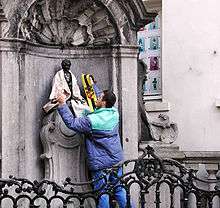
Manneken Pis is dressed in costumes, several times each week, according to a published schedule, which is posted on the railings around the fountain. Since 1954, the costumes are managed by the non-profit association "The Friends of Manneken-Pis", who review hundreds of designs submitted each year, and select a small number to be produced and used.[10]
His wardrobe consists of around one thousand different costumes, many of which may be viewed in a permanent exhibition inside the City Museum, located on the Grand Place, immediately opposite the Town Hall. In February 2017, a specially designed museum, at 19, rue du Chêne/Eikstraat, called Garderobe MannekenPis, opened its doors.[11]
Although the proliferation of costumes is of twentieth-century origin, the occasional use of costumes dates back almost to the date of casting; the oldest costume on display, in the City Museum, being of seventeenth-century origin.[12] In 1756, an inventory indicates that Manneken Pis had five complete costumes. From 1918 to 1940, he was offered some thirty costumes. But it was especially after 1945 that the movement took on an exceptional dimension; he had more than 400 costumes in 1994, more than 750 in 2005, and more than 950 in 2016.[13] The changing of the costume, on the figure, is a colourful ceremony, often accompanied by brass band music. Many costumes represent the national dress of nations whose citizens come to Brussels as tourists; others are the uniforms of assorted trades, professions, associations, and branches of the civil and military services.
 Manneken Pis dressed as Dracula (15 March 2002)
Manneken Pis dressed as Dracula (15 March 2002)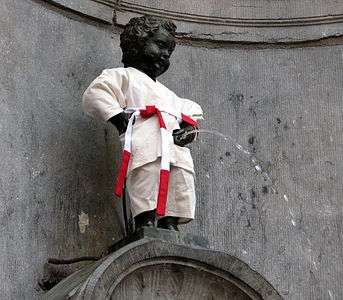 Manneken Pis in judo attire (2008)
Manneken Pis in judo attire (2008) Replica of the outfit offered by Maximilien Emanuel of Bavaria in 1697 (2009)
Replica of the outfit offered by Maximilien Emanuel of Bavaria in 1697 (2009)
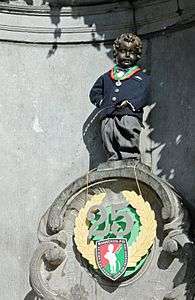 25th anniversary of the Ordre des Amis du Manneken-Pis (3 September 2011)
25th anniversary of the Ordre des Amis du Manneken-Pis (3 September 2011) Manneken Pis dressed as mayor member of the Seven Noble Houses of Brussels (902nd costume, 22 June 2013)
Manneken Pis dressed as mayor member of the Seven Noble Houses of Brussels (902nd costume, 22 June 2013)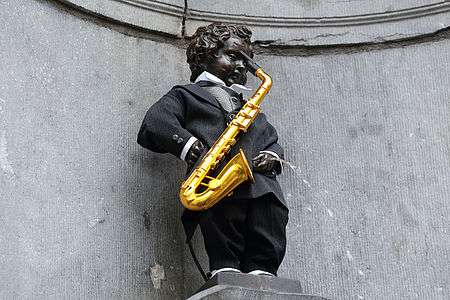 A saxophone for Manneken Pis on the 200th birthday of Adolphe Sax (6 November 2014)
A saxophone for Manneken Pis on the 200th birthday of Adolphe Sax (6 November 2014).jpg) Manneken Pis 1000th costume (13 May 2018)
Manneken Pis 1000th costume (13 May 2018)
Folklore
On certain occasions (Saint-Verhaegen, planting of the Meyboom), the statue is hooked up to a keg of beer. Cups will be filled up with the beer flowing from the statue and given out to people passing by.[2][14]
Location and accessibility
Manneken Pis is located in the centre of Brussels, only five minutes' walk from the Grand Place, at the junction of the Rue du Chêne/Eikstraat and the pedestrian Rue de l'Étuve/Stoofstraat.
This site is served by the premetro station Bourse (on lines 3 and 4) and the bus stops Grand Place and Cesar de Paepe.
Replicas
In Belgium
Although the Manneken Pis of Brussels is the best-known, others exist. There is an ongoing dispute over which Manneken Pis is the oldest – the one in Brussels or the one in Geraardsbergen.[15] Similar statues can also be found in the Belgian cities of Koksijde, Hasselt, Ghent, Bruges, in the town of Braine-l'Alleud (where it is called "Il Gamin Quipiche"), and in the French Flemish village of Broxeele, a town with the same etymology as Brussels.
Internationally
Since the 20th century, numerous copies or imitations of Manneken Pis have been created both in Belgium and abroad. It is necessary to distinguish the official copies offered by the City of Brussels from copies and imitations carried out privately by admirers of the little statue.
Official copies were offered to:







In many countries, replicas in brass or fiberglass are common swimming or garden-pool decorations. Many copies exist worldwide as garden ornaments. Manneken Pis has also been adapted into such risqué souvenir items as ashtrays and corkscrews.
In Bali, Indonesia, there is a Belgian restaurant called Mannekepis. It even has the exact replica of the statue standing in front of the restaurant, urinating.
In September 2002, a Belgian-born waffle-maker set up a replica in front of his waffle stand in the Orlando Fashion Square mall, in Orlando, Florida. He recalled the legend as "the boy who saved Brussels from fire by extinguishing it with his urine" (confusing the legend with an incident in Gulliver's Travels perhaps). Some shocked shoppers made a formal complaint. Mall officials said that the waffle-shop owner did not follow procedures when he put up the statue and was therefore in violation of his lease.[16]
In contrast, there is a similar statue in Rio de Janeiro, in front of the quarters of Botafogo de Futebol e Regatas, a famous Brazilian football club. There, the presence of the statue is taken lightly, and it has even been adopted as a mascot by the club. Fans usually dress it with the club's jersey, after important wins.
A working replica of Manneken Pis stands on the platform of Hamamatsuchō Station in Tokyo, Japan. The statue is a great source of pride for station workers who dress it in various costumes—traditional and otherwise—at different times of year.[17]
Statues inspired by Manneken Pis
Since 1987, Manneken Pis has had a female equivalent, Jeanneke Pis, located on the east side of a small alley called the Impasse de la Fidélité/Getrouwheidsgang, near the Rue des Bouchers, representing a little girl squatting in the act of urinating. It feeds a small fountain. It is, however, less illustrious than its masculine counterpart.[18]
Het Zinneke, depicting a dog urinating against a marker, can be seen as a reference to Manneken Pis. It is, however, not associated with a fountain. Zinneke means bastard in Brussels' dialect.[19]
 Jeanneke Pis statue, in Brussels
Jeanneke Pis statue, in Brussels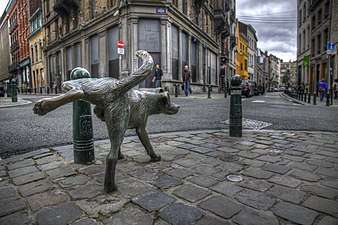 Het Zinneke statue, in Brussels
Het Zinneke statue, in Brussels
In popular culture
- A promotional expansion for the board game 7 Wonders allows a player to build an eighth wonder of the world: Manneken-Pis.[20]
- The film The Party, starring Peter Sellers, includes a reproduction of the statue in the house's extended water feature. The statue's peeing can be changed at an extended intercom panel, and Sellers, as Hrundi V. Bakshi, soaks a guest when he hits the wrong button.
- In the 1986 film The Money Pit, the lead character, Walter Fielding, played by Tom Hanks, accidentally falls in a construction area where workers are renovating his home. In a sequence reminiscent of a Rube Goldberg machine, he stumbles through a window, across the roof, down a scaffold, finally into a wheeled bin in which he rolls down a hill and is dumped into a fountain resting directly under a replica of the Manneken Pis.
- Manneken Pis is a 1995 Belgian comedy-drama film, directed by Frank Van Passel and written by Christophe Dirickx. It premiered in May 1995 at the Cannes Film Festival. It received the André Cavens Award for Best Film and four awards at the Joseph Plateau Awards. The film was selected as the Belgian entry for the Best Foreign Language Film at the 68th Academy Awards, but was not accepted as a nominee.
See also
References
- ↑ "Brussels Landmarks and Monuments: Brussels-Capital Region, Belgium". www.world-guides.com. Retrieved 2018-02-02.
- 1 2 "Manneken Pis Brussels Belgium". Brussels.info. Retrieved 2015-03-08.
- ↑ Naomi Miller, Fountains as Metaphor from Fountains, Splash and Spectacle, Water and Design from the Renaissance to the Present, edited by Marilyn Symmes, Thames and Hundson and Cooper-Hewitt National Design Museum, Smithsonian Institution. 1998
- 1 2 3 4 5 6 Willsher, Kim (6 August 2015). "Fake pisstake? Scientists re-examine Belgium's celebrated Manneken Pis". The Guardian. Retrieved 7 June 2017.
- 1 2 3 4 5 6 7 8 9 10 "Le plus célèbre Bruxellois". www.mannekenpis.brussels. Retrieved 2017-08-20.
- 1 2 "Manneken-pis - Brussels City Museum". www.brusselscitymuseum.brussels (in French). Retrieved 2017-08-20.
- ↑ "ZWANZE : Définition de ZWANZE". www.cnrtl.fr (in French). Retrieved 2018-02-02.
- ↑ "Background | VIVAQUA". www.vivaqua.be. Retrieved 2018-06-15.
- ↑ "Manneken Pis - Symbol of Brussels, history and legend". www.introducingbrussels.com. Retrieved 2018-06-15.
- ↑ "Manneken Pis: costumes worn by the statue of the urinating toddler in Brussels". The Telegraph. Retrieved 24 June 2017.
- ↑ "New Brussels museum displays costumes of Manneken Pis statue". Reuters. 3 February 2017. Retrieved 2017-08-20.
- ↑ "Manneken Pis in Brussels to be dressed as Kyivska Rus prince". en.censor.net.ua. 22 August 2016. Retrieved 24 June 2017.
- ↑ "List of costume | Manneken Pis". www.manneken-pis.be. Retrieved 2017-08-20.
- ↑ "HLN Bizar - Manneken Pis plaste Maltees bier (1122097)". Hln.be. Retrieved 2011-12-08.
- ↑ "Et si le Manneken Pis de Bruxelles n'était pas unique?". RTBF Info (in French). 2009-06-16. Retrieved 2017-09-29.
- ↑ https://nypost.com/2002/09/19/weird-but-true-166/
- ↑ "Manneken Pis at Hamamatsuchō Station, Tokyo - Japan Guide". Japan Guide. 2015-01-07. Retrieved 2017-09-09.
- ↑ "Jeanneke Pis". visit.brussels. Retrieved 2018-06-15.
- ↑ "Peeing statues". Retrieved 2018-06-15.
- ↑ "7 Wonders: Manneken Pis Promo | Board Game". BoardGameGeek. Retrieved 2011-12-08.
Relevant literature
- Emerson, Catherine. Regarding Manneken Pis: Culture, Celebration and Conflict in Brussels. London: Legenda. 2015.
External links
| Wikimedia Commons has media related to Manneken Pis van Brussel. |
- manneken-pis.be, Manneken Pis website
- Brussels.be, Official website with calendar of costume changes
- Ilotsacre.be, Manneken Pis: virtual visit, pictures and costumes
- VisitOnWeb.com, Manneken Pis in 360 degrees
- Manneken Pis on BALaT - Belgian Art Links and Tools (KIK-IRPA, Brussels)